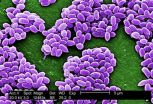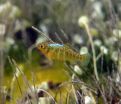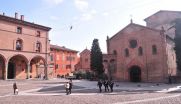Understanding how glasses 'relax' provides some relief for manufacturers
2011-04-28
(Press-News.org) Manufacturers who design new materials often struggle to understand viscous liquids at a molecular scale. Many substances including polymers and biological materials change upon cooling from a watery state at elevated temperatures to a tar-like consistency at intermediate temperatures, then become a solid "glass" similar to hard candy at lower temperatures. Scientists have long sought a molecular-level description of this theoretically mysterious, yet common, "glass transition" process as an alternative to expensive and time-consuming trial-and-error material discovery methods. Such a description might permit the better design of plastics and containers that could lengthen the shelf life of food and drugs.
A fundamental question is why many materials behave differently when temperature changes. In some "fragile" glass-forming materials, a modest variation in temperature can make the material change from highly fluid to extremely viscous, while in "strong" fluids this change in viscosity is much more gradual. This effect influences how long a manufacturer has to work with a material as it cools. "For decades, material scientists have heavily relied on empirical rules of thumb to characterize these materials," says NIST theoretician Jack Douglas. "But if you want to design a material that does precisely what you want, you need a molecular understanding of the underlying physical processes involved."
According to Douglas, the increasingly viscous nature of glass-forming liquids is related to molecules that move together in long strings around other atoms that are almost frozen in their motion. The growth of these snake-like structures leads to an increase in the viscosity of the liquid: the lower the temperature, the longer the chains, and the more viscous the fluid. The team found that the rate at which these spontaneously organizing snake-like strings grow in size as the material cools is quantitatively related mathematically to the fluid fragility—confirming intuitive arguments made nearly half a century ago by physicists G. Adams and J.H. Gibbs, but now bolstering them with a firm computational underpinning.
Douglas and his collaborator Francis Starr of Wesleyan University achieved a large variation of fluid fragility through use of a computer model, which mimics a polymer fluid that includes tiny nanometer-sized particles. Portraying the addition of various amounts of nanoparticles and varying their interaction with the polymers, Starr says, gave the team a sort of "knob to tweak" to reveal how the fluidity changed with temperature and how the motion of the clusters was quantitatively related to changes in the fluid's properties. This tuning of cooperative motion in glass-forming liquids and fragility should be crucial in material design. Douglas says.
###
* F.W. Starr and J.F. Douglas. Modifying fragility and collective motion in polymer melts with nanoparticles. Physical Review Letters, week ending March 18, 2011, Vol. 106, 115702 pp. 1-4.
DOI: 10.1103/PhysRevLett.106.115702
END
ELSE PRESS RELEASES FROM THIS DATE:
2011-04-28
It may not be as catchy a combination as "Miss Scarlet in the parlor with a revolver," but "polyester-rayon wipes in the field followed by saline-surfactant extraction and vortexing" is the most efficient solution to an important biological game of "Clue" deduced by researchers at the National Institute of Standards and Technology (NIST). As reported in a recent paper*, the NIST team studied different methods for collecting, extracting and quantifying microbial spores from indoor surfaces to estimate parameters that should be considered in the development of a standard ...
2011-04-28
Two groups of small fish, one from a Caribbean island and one from the Yucatan peninsula of Mexico, exhibit some of the fastest rates of evolution known in any organism, according to a new UC Davis study.
About 50 species of pupfish are found from Massachusetts to Venezuela -- and they are all pretty much the same, said lead study author Chris Martin, a UC Davis graduate student working with Peter Wainwright, a professor of evolution and ecology at UC Davis.
"They look the same and they act the same," eating detritus and algae off rocks, Martin said.
Except in two ...
2011-04-28
It is, undoubtedly, a huge privilege to live in a world crammed with the most incredible "must see" sights; however many lesser known places, hidden away in tucked away corners, often provide the most rewarding and personal experiences. Here are our Top 10 "Sight Swaps"...
1. Pisa for Bologna
Queue behind tourists from all corners of the world to have your photo taken trying to "push back up" the leaning tower of Pisa, or head instead to the mediaeval leaning towers of Bologna, one of the largest and most perfectly preserved historic centres ...
2011-04-28
Los Angeles, CA (APRIL 26, 2011) Despite the fact that nearly one-third of American households have a firearm, studies show that having a gun in the home poses a household a greater health risk than a potential benefit. A new study released in the American Journal of Lifestyle Medicine (published by SAGE) examined scientific research on both sides of the debate to put hard numbers to this on-going discussion.
Author David Hemenway studied the various risks of having a gun in the home, including accidents, suicide, homicide, and intimidation. Additionally, the benefits ...
2011-04-28
The antimatter equivalent of helium nuclei has been produced by an international team of physicists working with the Relativistic Heavy Ion Collider at the U.S. Department of Energy's Brookhaven National Laboratory in New York. Two University of California, Davis, professors are members of the team. A paper describing their results is published online this week by the journal Nature.
"This is the heaviest antimatter anyone has ever created," said Manuel Calderon de la Barca Sanchez, professor of physics at UC Davis and an author of the paper. Authors also include Daniel ...
2011-04-28
You may have heard, watched or read the story...a seaside community zoo becomes the first U.S. zoo to perform a full-scale, total evacuation during a hurricane. The Alabama Gulf Coast Zoo made headlines in 2004 when Zoo Director Patti Hall relocated over 270 exotic zoo animals, a staff and their families, to her inland home to wait out Hurricane Ivan (category 4 storm). The zoo was destroyed, and while rebuilding, endured two more unprecedented evacuations ten months later during Hurricanes Dennis and Katrina.
If this story doesn't ring a bell, it will... as the Alabama ...
2011-04-28
ST. PAUL, Minn. –Group appointments where doctors see several people for a longer time may be feasible for Parkinson's disease, according to a new study published in the April 27, 2011, online issue of Neurology®, the medical journal of the American Academy of Neurology (AAN).
Group visits have shown benefits for people with other chronic conditions, but have not been evaluated for people with Parkinson's disease. Group visits can allow patients more time with their doctor than they might have with individual appointments and more time for doctors to provide education ...
2011-04-28
In this month's Physics World, Richard Taylor, professor of physics, psychology and art at the University of Oregon, warns that artificial retinal implants – a technology fast becoming a reality – must adapt to the unique features of the human eye in order to become an effective treatment.
The gap between digital camera technology and the human eye is getting ever smaller, in terms of both the number of light-sensitive detectors and the space that they occupy. A human retina typically contains 127 million photoreceptors spread over an area of 1100 mm2. In comparison, ...
2011-04-28
Using advanced DNA analysis and extensive field work, an international research team has confirmed the link between leprosy infection in Americans and direct contact with armadillos. In a joint collaboration between the Global Health Institute at EPFL in Switzerland and Louisiana State University, clear evidence was found that a never-before-seen strain of Mycobacterium leprae has emerged in the Southern United States and that it is transmitted through contact with armadillos carrying the disease. The results will be published on April 28th in the New England Journal of ...
2011-04-28
Durham, N.C., and New York, N.Y.. – Researchers at Duke University Medical Center and St. Luke's and Roosevelt Hospital Center, Columbia University, have uncovered a new clue for why bariatric surgery is more effective than dietary remedies alone at controlling glucose levels.
This discovery, and facts gleaned from their previous studies, provide even more evidence that branched-chain amino acids are biomarkers that deserve careful scrutiny in the development and treatment of diabetes.
Physicians have observed that bariatric surgery results in improved blood sugar ...
LAST 30 PRESS RELEASES:
[Press-News.org] Understanding how glasses 'relax' provides some relief for manufacturers



